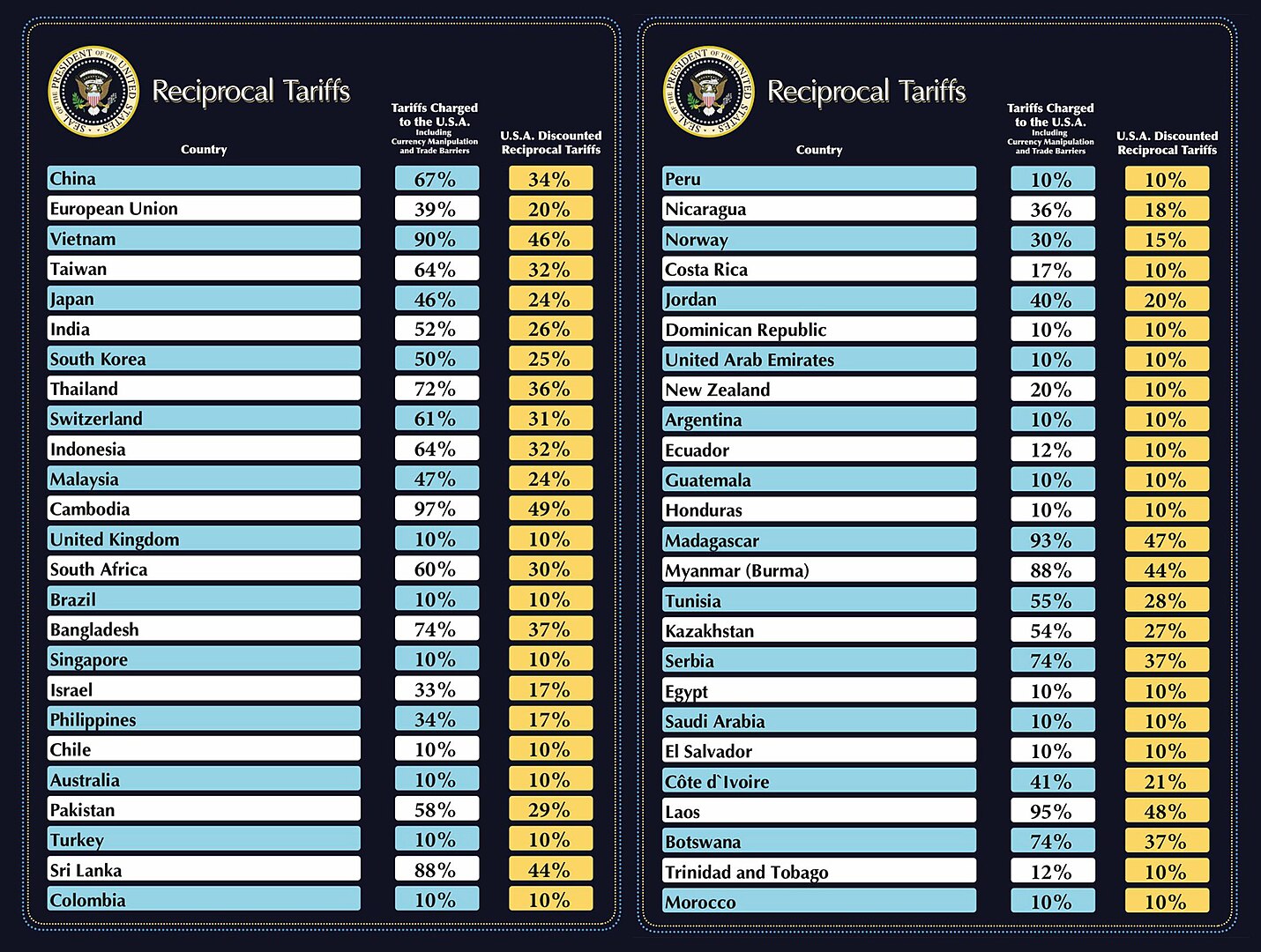Story at a glance…
-
President Trump announced a new tariff regime that has placed at least a 10% tax on imports from all US trading partners.
-
Economists, analysts, traders, and politicians around the world and the political spectrum have criticized them and forecasted economic downturns.
-
WaL looked through most financial news sources and think tanks to see if a single economist could be found advocating for these tariffs as a positive policy.
Economics must be the only academic discipline completely free from the appeal to authority fallacy—that one can have a responsible and valid opinion or policy in economics only if they are considered an expert in the field. This was the kind of thinking that dominated during COVID-19 and in discussions about climate change, with slogans like “follow the science” and “there is broad scientific consensus” demonstrating how much more revered the epidemiologist and climatologist are than the economist.
Few events in the last 25 years will have encapsulated the absence of economics in the importance of the public mind than Donald Trump’s “Liberation Day” event announcing baseline tariffs of 10% on all trading partners, and even on some uninhabited islands in the middle of the ocean.
Many of the tariffs climb far higher than 10%, and combined with previous punitive trade measures, costs to import products from China could total 60% of the product’s value.
But the worst isn’t only reserved for America’s adversaries. Taiwan, a nation discussed by national security experts as worth defending militarily from China explicitly because we buy so many state-of-the-art computer chips from the island, has been subjected to a 32% tariff.
Trump says the tariff schedule will raise $2.2 trillion in import duties by 2030, and if Trump and his commerce team came up with all these tariff rates individually, the leyman might consider, there must be some good reasoning behind the strategy that has been roundly denounced by all world leaders who care to comment.
Rejecting the premise that there is no value in appealing to authority in economics, WaL invites the reader to take a look at the commentary from the nation’s many economic and enterprise publications to see what the experts have to say.
Shoring up
There are two chief reasons that Trump gives for his tariff plan. The first is the belief that if the US has a trade deficit with a nation, this is the equivalent of being “ripped off” and “treated badly”. The second is that by discouraging countries from exporting to the US, American firms will bring back critical manufacturing sectors to these shores.
Will tariffs help achieve either of these?
“From an economic standpoint, there’s little difference between the tariffs favored by Trump and the subsidies embraced by Biden: both shape production and impose real costs,” writes Allison Schrager, a senior fellow at the Manhattan Institute, for City Journal. “…America is overly dependent on foreign goods—especially from China… but reducing reliance on Beijing doesn’t necessarily mean making everything at home”.
Rather than increasing trade with trusted partners, Trump’s push to reshore includes Europe, Mexico, and Canada as well, which are now under tariffs of 20%, 25%, and 25% respectively. Steel, aluminum, and foreign cars from any country anywhere are subjected under the new schedule to 25% import tariffs, meaning Trump hopes to not only bring back finished goods manufacturing, but lower-order production goods as well.
In short, unless both the materials and the items are manufactured in the US, producers and consumers are going to be paying more at some stage in the process.
“While Trump’s industrial policy may create some manufacturing jobs, the American economy’s shift away from domestic production was structural, the result of long-running changes in our labor force and technology that neither tariffs nor subsidies can reverse”.
The Wall Street Journal reports that some companies, like Taiwan Semiconductor Manufacturing Company and German conglomerate Siemens, are intending to invest billions in American-based expansions, but adds nonetheless that simply changing course on a 30+ year trend of offshoring and globalization of supply chains is going to be excessively costly for businesses.
“Shifting things around is going to be quite complicated,” said Derrick Kam, Asia economist at Morgan Stanley. That process will be slow, expensive, and challenging, he said. Additionally, there’s nothing to suggest these tariffs will continue in the long term, as the President has already said in some cases that they will be removed if certain concessions are met—such as in the case of Mexico stifling the flow of drugs and immigrants across the southern border.
Imagine a corporation paying several billion dollars to reshore its manufacturing arm in the US from Vietnam, only for the tariffs on Vietnam to be removed under the next presidency. For this reason, many companies will opt to stay where they are and hike prices for the consumer rather than undertake costly relocations.

Ripping us off
Experts say that there’s nothing inherent in a negative trade balance that automatically means the US is being taken advantage of.
“Our President claims that the US is victimized by a negative balance of trade: we buy more from Canada and other countries than they purchase from us,” writes economist Walter Block, the Harold E. Wirth Eminent Scholar in Economics at the School of Business at Loyola University New Orleans. “However, I have a horrid balance of trade with McDonald’s and Wal-Mart. I acquire several hundreds of dollars’ worth of their products every year, and neither has yet seen fit to reciprocate with any of my economic services”.
For example, both Block and Schrager point to the economic law of comparative advantage—the former with an example of Canada producing more maple syrup than Costa Rica, which in turn produces more bananas than Canada—and the latter by pointing out the disparity between East and West in the production of semiconductors.
Taiwan’s tariff rate was set at 32%, which neatly demonstrates how not even Trump’s team truly believes that a balance of trade is negative by definition, because Taiwan’s enormous semiconductor exports to the US were not considered when making the tariff rate because of their importance to national security systems. In this case, because the chips go into making missiles, jets, and radar systems, the imbalance of trade is viewed positively.
The East at large has seen the brunt of the tariff regime, amounting to 46% for Vietnam, 24% for Japan, 25% for South Korea, 26% for India, and 36% for Thailand. Leaders in several of these countries have spoken openly of future negotiations with the US to have the rate hopefully lowered, but at the moment, nations who routinely have to balance political relations with the US and economic/neighborly relations with China have suddenly had a very significant reason to focus on the latter than the former.
“Asian economies will be hit harder than most by US reciprocal tariffs,” Marcel Thieliant, head of Asia-Pacific at Capital Economics, told Reuters. “Not only do Asian economies face higher tariffs than many others, they are also more dependent on US goods demand than most”.
The US leads the world in exporting services, virtually doubling the second-highest nation in the UK, more than doubling the third-highest in Germany, and leading China by a similar margin as what China maintains over the US in manufacturing. Part of this incredible rise in providing services like banking, tech design and support, cloud and other software development, and legal counseling was the restructuring that Schrager spoke of—a deliberate shift in the US workforce away from physical labor and towards mental labor.
A result of this was not only increased goods deficits with countries in Asia, but also better relations with those countries, two of whom the US conducted populocidal wars against.
Not only were trade imbalances one of the justifications for applying the tariffs, but they were also used directly as a method of calculating the tariff schedule. James Surowiecki, editor at The Yale Review posted on X a rather convincing case for having “cracked the code” of the rationale behind each country’s individual tariff.
“They didn’t actually calculate tariff rates + non-tariff barriers, as they say they did. Instead, for every country, they just took our trade deficit with that country and divided it by the country’s exports to us,” he wrote. “So we have a $17.9 billion trade deficit with Indonesia. Its exports to us are $28 billion. $17.9/$28 = 64%, which Trump claims is the tariff rate Indonesia charges us. What extraordinary nonsense this is”.
How, What, Why?
In the executive order signed by Trump that included the tariffs, the President highlighted one very strong US industry in particular as being hurt by the trade imbalance, further suggesting that there is a lack of economic literacy in his decision.
“This trade deficit reflects asymmetries in trade relationships that have contributed to the atrophy of domestic production capacity, especially that of the… defense-industrial base,” the executive order said. The defense-industrial base, which is also called the military-industrial complex, could hardly be described as having suffered from anything over the last 25 years.
Further questions as to the wisdom of this tariff policy can be found in POLITICO, which quoted a White House ally close to Trump’s inner circle over the weekend as saying, “No one knows what the f— is going on”.
“What are they going to tariff? Who are they gonna tariff and at what rates? Like, the very basic questions haven’t been answered yet”.
“White House trade advisor Peter Navarro expects these tariffs to raise $600 billion annually,” writes economist Jonah Goldberg, Senior Fellow and Asness Chair in Applied Liberty at the American Enterprise Institute. “Nearly every serious economist across the ideological spectrum understands that American consumers would pay the bulk of that. Thus, if ‘successful,’ Trump would be imposing the largest, most regressive tax increase in history”.
“For starters, many people understand that tariffs on, say, foreign steel make foreign steel more expensive. As a result, the things we make from foreign steel become more expensive, too. What gets overlooked, however, is that taxing foreign steel also makes domestic steel more expensive. When you make something more scarce—steel, eggs, Taylor Swift tickets—prices go up,” he adds.
Since none of the economists WaL could find had anything positive to say about tariffs, let’s look at some others with predictions.
“We will likely see retaliation from Europe but it’s clear countries will think about how to retaliate in a politically astute way,” said Justin Onuekwusi, chief investment officer at the investment firm St James’s Place, in London. “Significant retaliation could lead to a tariff ‘spiral of doom’ that could be the growth shock that drags us into recession,” he said.
“We have raised global recession risks to 35 percent from 15 percent,” he added.
“Never before has an hour of Presidential rhetoric cost so many people so much. Markets continue to move after my previous tweet. The best estimate of the loss from tariff policy is now is closer to $30 trillion or $300,000 per family of four,” said economist Larry Summers on X. Summers previously told Bloomberg that the tariff hikes are set to unleash an “oil crisis-like shock to the economy”. WaL
We Humbly Ask For Your Support—Follow the link here to see all the ways, monetary and non-monetary.
PICTURED ABOVE: Trump at the signing ceremony in the Rose Garden next to a chart showing each country’s tariff rates. PC: The White House via Flickr



